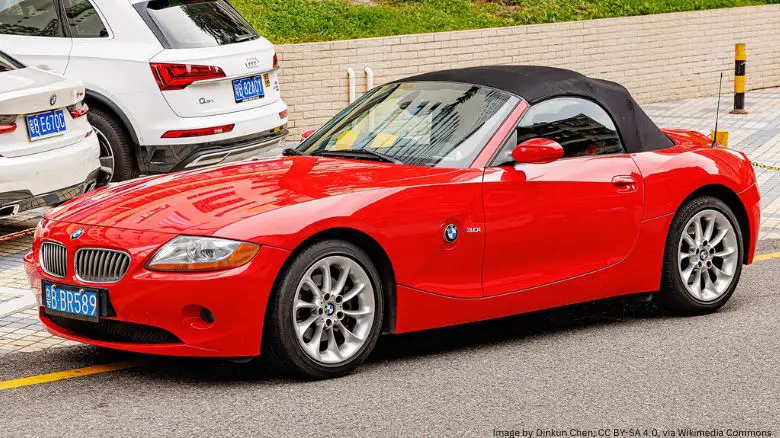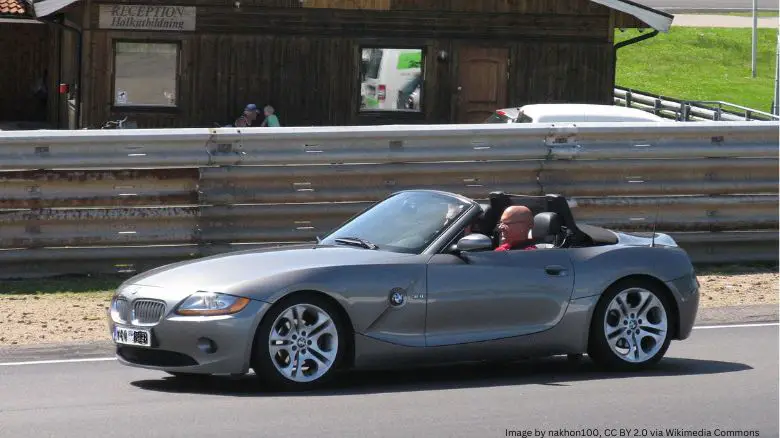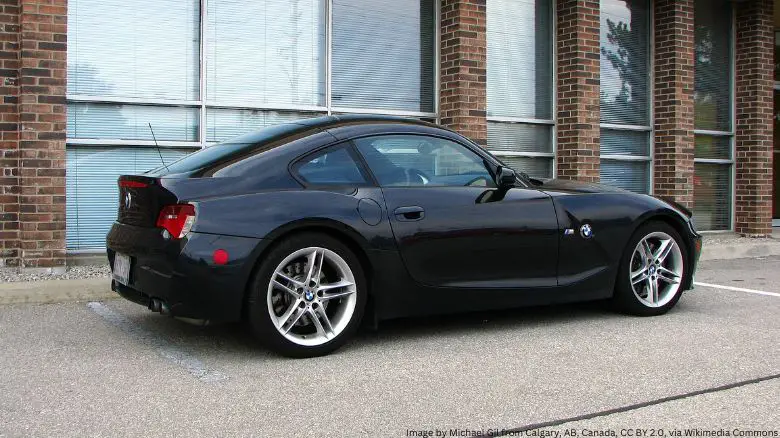Will the BMW Z4 Be a Future Classic?

Adam Chinn
Founder, The Car Investor
The first-generation BMW Z4 occupies a unique position in automotive history. When it debuted in 2002, Chris Bangle's controversial design divided opinion like few cars before it.
Two decades later, as the automotive world shifts toward electrification and the era of naturally aspirated roadsters draws to a close, the question becomes increasingly relevant: could this polarizing BMW become a future classic?
The answer isn't straightforward, but recent market trends and the Z4's distinctive characteristics suggest it may be ready for serious consideration among collectors and enthusiasts.
The Design Revolution That Divided Opinion
Flame Surfacing: From Controversy to Character
The E85 Z4's design, penned by Chris Bangle and Anders Warming, introduced BMW's "flame surfacing" design language - a radical departure from the conservative lines that had defined BMW for decades.
The flowing, sculptural bodywork was unlike anything in BMW's portfolio, featuring dramatic curves and complex surface changes that looked more like a concept car than a production vehicle.

This design audacity initially drew harsh criticism from BMW traditionalists who felt the company had abandoned its design heritage. However, controversy often breeds collectibility.
Cars that polarize opinion upon release - think of the Porsche 996's "fried egg" headlights or the Ferrari 348's angular styling - often become highly sought after once their design significance is recognized.
The Z4's distinctive "flame surfaces" now appear prophetic rather than problematic, predicting the sculptural complexity that would define automotive design in the following decades. What once seemed radical now looks like pioneering work that influenced an entire generation of car design.
Functional Beauty
Beyond its striking appearance, the Z4's design served functional purposes. The car's long hood and short overhangs weren't just aesthetic choices - they accommodated the front-mid engine position that gave the Z4 its excellent 50:50 weight distribution.
The distinctive side vents weren't mere styling exercises but functional cooling ducts for the brakes and engine bay.
This marriage of form and function, where dramatic styling serves performance purposes, is a hallmark of classic car design that the Z4 exemplifies better than many of its contemporaries.
Engineering Excellence and Driving Dynamics
Advertisement
The Heart of the Matter: Engine Options
The first-generation Z4 offered a range of powerplants that catered to different driving preferences, each with its own classic car potential:
2.5i and 3.0i Models: The naturally aspirated inline-six engines provided smooth, linear power delivery and the distinctive BMW straight-six soundtrack. The 3.0-liter unit, producing 231 horsepower, offered an ideal balance of performance and refinement.
Z4 M Roadster and Coupe: The range-topping M variants featured the legendary S54 engine from the E46 M3, producing 330 horsepower. This high-revving, naturally aspirated unit is now recognized as one of the finest engines BMW ever produced, making M versions particularly desirable.
Z4 3.0si: The final iteration of the first generation included a revised 3.0-liter engine with 255 horsepower, representing the most refined version of the naturally aspirated Z4 experience.
Chassis Dynamics
The Z4's rear-wheel-drive layout, near-perfect weight distribution, and well-tuned suspension created a driving experience that many contemporary reviews praised for its balance and engagement.
Unlike many modern performance cars that rely on electronic aids, the Z4 delivered its thrills through fundamental engineering excellence.
The car's relatively light weight (around 3,200 pounds for most variants) and responsive steering created a connection between driver and machine that's increasingly rare in today's automotive landscape.
This pure driving experience is exactly what classic car enthusiasts seek.
Market Performance and Collectibility Indicators
Current Market Trends
Recent market data shows encouraging signs for Z4 values, particularly for well-maintained examples and M variants. After experiencing typical depreciation through their first decade, clean first-generation Z4s have begun showing price stability and even appreciation since 2020.

Several factors contribute to this trend:
Increasing Scarcity: Many Z4s have been lost to accidents, poor maintenance, or modification. Clean, original examples are becoming genuinely rare, particularly in desirable colors and specifications.
Recognition of Design Significance: As automotive design has evolved, the Z4's pioneering flame surfacing is increasingly recognized as historically significant rather than merely controversial.
End of an Era: The Z4 represents one of the last naturally aspirated, lightweight roadsters from a major manufacturer, making it a symbol of a bygone automotive era.
Special Editions and Variants
Certain Z4 variants show particularly strong classic car potential:
Z4 M Models: Both roadster and coupe versions are highly sought after, with the coupe's unique "double bubble" roof making it especially distinctive. The S54 engine's reputation continues to grow among enthusiasts.
Alpina Roadster S: This rare variant, tuned by BMW's performance partner Alpina, produced 300 horsepower and featured unique styling elements. With extremely limited production, these cars command significant premiums.
Late-Production 3.0si: The final first-generation models often represent the most refined expression of the Z4 concept and may appreciate as "last of line" examples.
Competitive Analysis: Standing Out from Contemporaries
Advertisement
Against the Porsche Boxster
While the Boxster has already achieved recognition as a modern classic, the Z4 offers several advantages:
More distinctive styling that's immediately recognizable
Front-engine, rear-drive layout preferred by driving purists
Generally lower current prices offering better entry points for collectors
The Boxster's mid-engine layout and Porsche pedigree give it certain advantages, but the Z4's unique character may ultimately prove more collectible.
Against the Honda S2000
The S2000 has already achieved strong appreciation, but the Z4 offers different appeals:
More refined and comfortable for regular use
Wider range of engine options catering to different preferences
More distinctive design that stands out from other roadsters
Both cars represent the end of the naturally aspirated roadster era, but the Z4's German engineering and distinctive styling may give it longer-term appeal.
Ownership Considerations
Reliability and Maintenance
The Z4 generally proves more reliable than its exotic competitors, though certain issues are worth noting:
Common Problems:
Window regulator failures in roadster models
Cooling system components requiring replacement around 80,000-100,000 miles
Soft-top mechanism maintenance for roadster variants
Maintenance Costs: While higher than mainstream cars, Z4 maintenance costs are reasonable for a BMW performance car, especially compared to exotic alternatives.
Parts Availability: BMW's extensive dealer network and strong aftermarket support ensure parts availability for the foreseeable future.
Which Z4 to Choose
For classic car potential, certain variants stand out:
Best Overall Choice: Z4 3.0i or 3.0si with manual transmission offers the ideal balance of performance, reliability, and future collectibility.
Highest Appreciation Potential: Z4 M variants, particularly the coupe, offer the strongest appreciation prospects due to their performance credentials and relative rarity.
Value Play: Clean 2.5i models provide entry-level access to Z4 ownership with potential for moderate appreciation.
Special Interest: Alpina Roadster S represents the ultimate first-generation Z4 for serious collectors.
The Classic Car Credentials
Advertisement
Design Significance
The Z4's flame surfacing design language proved influential across the automotive industry, making it historically significant beyond BMW's own lineup. This design leadership often translates to classic car status as the styling's importance becomes clear with time.

Cultural Impact
While not achieving the same cultural penetration as some sports cars, the Z4 appeared in various media and became associated with BMW's design renaissance in the early 2000s. This cultural footprint provides foundation for future classic status.
Technological Milestone
The Z4 represented BMW's commitment to pure roadster design at a time when many manufacturers were abandoning the segment. This dedication to the roadster ideal makes it significant in automotive history.
Future Outlook and Investment Potential
Market Timing
The Z4 appears to be at an inflection point similar to where other modern classics were a decade ago.
Early signs of appreciation, combined with increasing recognition of the car's significance, suggest favorable timing for potential buyers.
Factors Supporting Appreciation
Scarcity Through Attrition: Many Z4s have been lost to accidents or poor maintenance, making clean examples increasingly rare.
Design Recognition: Growing appreciation for Bangle-era BMW design enhances the Z4's historical significance.
End of Era: As one of the last naturally aspirated roadsters, the Z4 benefits from scarcity through technological change.
Undervalued Status: Compared to competitors like the Boxster, the Z4 remains relatively affordable, offering better upside potential.
Potential Challenges
Brand Perception: BMW's large production volumes and mainstream positioning may limit appreciation compared to more exotic alternatives.
Complexity: Modern electronics and systems may create maintenance challenges as cars age.
Market Saturation: Relatively high production numbers compared to true exotics may limit appreciation potential.
Conclusion: The Case for Classic Status
The first-generation BMW Z4 possesses many characteristics that define future classics: distinctive design, engineering excellence, cultural significance, and increasing scarcity.
While it may never achieve the stratospheric values of Italian exotica, the Z4 has strong potential for steady appreciation and classic car recognition.

The car's controversial design, once seen as a weakness, now appears to be its greatest strength. As automotive design becomes increasingly homogenized, the Z4's bold styling stands out more dramatically.
Combined with its excellent driving dynamics and growing scarcity, these factors position the Z4 favorably for future classic status.
For potential buyers, the timing appears opportune. Prices have stabilized after initial depreciation, but significant appreciation hasn't yet occurred.
Well-chosen examples - particularly M variants, manual transmission cars, and late-production models - offer the best combination of driving enjoyment and investment potential.
The Z4 may not be a traditional classic car candidate, but it represents something equally valuable: a distinctive, well-engineered automobile from a significant period in automotive history.
As the industry moves toward electrification and automation, the Z4's analog driving experience and dramatic styling become increasingly precious.
Future Classic Rating: 4/5
The BMW Z4's combination of design significance, engineering excellence, and growing scarcity positions it well for future classic status.
While challenges exist, the fundamentals support strong potential for appreciation and collector recognition.

About the Author
Adam Chinn is the founder of The Car Investor, combining his passion for classic cars with data-driven investment strategies to help collectors maximize their returns.
View all articles →Related Articles

Volvo 850 T-5R: The Sleeper That Shocked the Performance World
The Volvo 850 T-5R and 850 R have evolved from unconventional performance cars to cherished modern classics, representing one of the most successful transformations of a conservative brand into a genuine performance force.

Alfa Romeo 147 GTA: The Beautiful Lunatic That Defied Logic
The Alfa Romeo 147 GTA stands as automotive proof that passion can triumph over practicality, creating one of the most characterful and increasingly valuable hot hatchbacks ever built.

Will the Jaguar F-Type Become a Classic?
The Jaguar F-Type represents a fascinating case study in modern classic car potential. Launched in 2013 as Jaguar's spiritual successor to the legendary E-Type, the F-Type marked the British marque's return to dedicated sports car manufacturing after a 40-year hiatus.
Advertisement